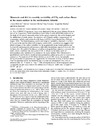Please use this identifier to cite or link to this item:
https://accedacris.ulpgc.es/jspui/handle/10553/49810
| Title: | Mesoscale and diel to monthly variability of CO2 and carbon fluxes at the ocean surface in the northeastern Atlantic | Authors: | Merlivat, Liliane González-Dávila, Melchor Caniaux, Guy Boutin, Jacqueline Reverdin, Gilles |
UNESCO Clasification: | 251002 Oceanografía química | Keywords: | Oceanic carbon cycling CO2 ocean uptake Biogeosciences |
Issue Date: | 2009 | Publisher: | 2169-9275 | Journal: | Journal of geophysical research. Oceans | Abstract: | Four CARIOCA Lagrangian buoys were deployed in the northeast Atlantic Ocean as part of the Programme Océan Multidisciplinaire Méso Echelle (POMME) dedicated to the study of the role of mesoscale eddies in biological production, the carbon budget, and the subduction of mode waters. An extensive set of hourly surface measurements of temperature, salinity, and carbon dioxide fugacity (fCO2) was collected from February to August 2001. The high‐frequency spatial and temporal variability observed in surface fCO2 and in the derived dissolved inorganic carbon (DIC) concentrations suggests that abrupt changes of the carbon variables are being generated along frontal patterns and filaments by submesoscale and mesoscale eddy‐eddy interactions, especially in winter. On the basis of a 1‐D model of the diurnal mixed layer along the buoy trajectory, we show that under certain conditions the diel cycle of DIC is driven by the daily cycle of photosynthesis and metabolic CO2 release at the ocean surface. This information is quantitatively used to derive in‐situ primary production, carbon gross, and net community production. The analysis of 107 observed diel cycles of DIC shows that episodic biological production processes are triggered by the mesoscale activity of surface eddies. Over the sampled period, the POMME area is a sink for atmospheric CO2 with an estimated flux of −4 mmol m−2 day−1. The calculated amount of anthropogenic carbon transported into the ocean interior by subduction of subpolar mode water is equal to 2.8 1013 gC yr−1. | URI: | https://accedacris.ulpgc.es/handle/10553/49810 | ISSN: | 2169-9275 | DOI: | 10.1029/2007JC004657 | Source: | Journal of Geophysical Research: Oceans [ISSN 2169-9275], v. 114 (C03010) |
| Appears in Collections: | Artículos |
SCOPUSTM
Citations
18
checked on Jun 8, 2025
WEB OF SCIENCETM
Citations
17
checked on Jun 8, 2025
Page view(s)
162
checked on Feb 22, 2025
Download(s)
123
checked on Feb 22, 2025
Google ScholarTM
Check
Altmetric
Share
Export metadata
Items in accedaCRIS are protected by copyright, with all rights reserved, unless otherwise indicated.
